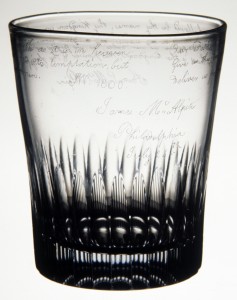Although objects created for use in the Church often have more obvious links to religion, pious references are not uncommon on items made for the home.
 Mug
Mug
Probably London, England; dated 1754
Earthenware (delftware)
Inscribed “Dame Well’s / 1754”
Museum purchase with funds provided by the Henry Francis du Pont Collectors Circle 2011.7.2
This silver-shape mug bears fine painted ornament portraying an elderly woman, presumably Dame Wells (or Well?), whose name and a date 1754 appear on the underside. The rural scene features a modest thatched and fenced home with a smoking chimney, perhaps representing the woman’s hospitality. Churches are not unusual on English ceramics, but the unusually detailed portrayal of such a building on side two of this mug suggests it may represent a particular building.
 Tumbler
Tumbler
United States or England; dated 1806
Glass (lead)
Inscribed with The Lord’s Prayer, “JW. 1806,” “James McAlpin /Philadelphia/ July 24th” and “Ann S. Mc.Alpin”
Museum purchase 1976.321
The Lord’s Prayer and other engraved inscriptions on this glass were almost certainly executed in Philadelphia. The initials “JW” may refer to a person who gave the glass to James and Ann McAlpin, perhaps to celebrate some special occasion. City directories list a James McAlpin as a merchant tailor from 1803 to 1817 and from 1818 onward as a gentleman.
 Quilt center
Quilt center
Worked by Sarah Furman Warner Williams
New York, New York; 1800–1820
Cotton, silk
Inscribed “Glory to God in the Highest Peace on Earth and good will to Men/ Hallelujah”
Bequest of Henry Francis du Pont 1959.1496a,b
This appliqué quilt center is all that survives from a larger bed covering by Sarah Furman Warner Williams, who made at least three religious-theme needlework quilts. The architecture of the inn portrayed on the quilt center echoes designs of the 1800s rather than ancient buildings dating to Christ’s lifetime. (Another quilt center by Williams is at Winterthur and portrays The Flight Into Egypt.)

Wine siphon
William Gale and Son
New York, New York; 1850–54
Silver
Gift of Denison and Louise Hatch 2001.2.21
Siphons were inserted into wine bottles, above the sediment, to pump liquid into decanters for serving at the table. As well as the original owner’s initials, this siphon bears a Latin inscription from the Book of Psalms (translated): “For in the hand of the LORD there is a cup, and the wine is red; it is full of mixture, and he poureth out of the same: but the dregs thereof all the wicked of the earth shall wring them out, and drink them.”
 Lantern slide
Lantern slide
United States or Europe; 1800s
Glass (nonlead)
Joseph Downs Collection of Manuscripts and Printed Ephemera, Winterthur Library 83×34.183
The small, fragile glass lantern slide seen in the reproduction here was almost certainly from a series of religious scenes. This view of the Last Supper was intended to be projected onto a wall or screen via a special lantern. The slide creator may have looked to a contemporary book illustration for inspiration.
Related Themes:


